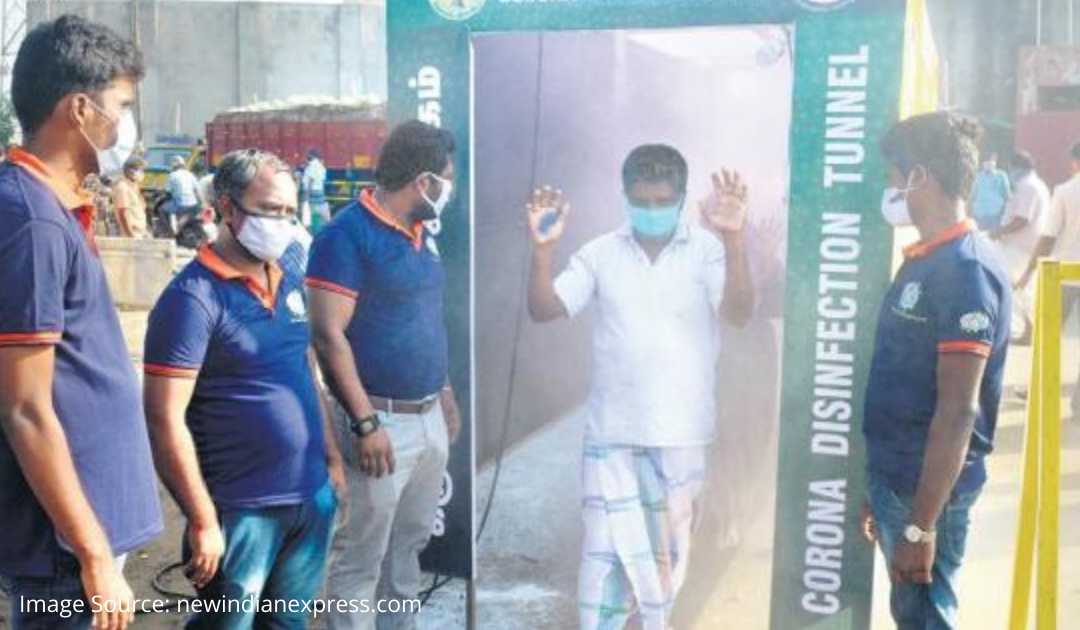The pandemic Coronavirus Disease 19 (COVID-19) has affected millions of lives and aroused the attention of the entire world. The pathogen Severe Acute Respiratory Syndrome 2 (SARS- CoV-2) is a novel coronavirus. Coronaviruses are enveloped- virus with a non-segmented, positive-sense, single-stranded RNA having the size ranging from 26,000 to 37,000 bases which is the largest known genome among RNA viruses [1]. Persons infected with COVID -19 usually have fever, and lower respiratory tract symptoms while estimated incubation time is 14 days. The transmission of this virus is fast. According to Wu et al. (2020), the reproduction number (Ro) of SARS-COV-2 is 2.68, which means for every infected person it can infect a mean of 2.68 people with an epidemic doubling time of 6.4 days [2]. With this serious global problem, it has led to create a solution that can be a public value. One example of innovations is the construction of tunnel disinfection.
Tunnel disinfection is an integrated, hydraulic system which releases atomized biocides and virucides. It provides safe protection and entry for everyone particularly for those who are working in high risk area. Tunnel disinfection can be installed at the entrance of public offices, pharmacies, supermarkets, airports, hospitals, ports, stations etc. [3]. In human disinfection, the person passes through the disinfection tunnel and get sanitized by means of fogging disinfectant liquid from the nozzle. The fog does not wet on the person since it turns into fog cloud. At the same time, the foot bath or a hygiene mat soaked with disinfectant will disinfect the feet of the person.
Tunnel disinfection is already availed worldwide. In China, a company in the southwestern Chinese City of Chongqing built a tunnel equipped with disinfectant to spray their employees before they begin to work [4]. In India, the Tiruppur district of Tamil Nadu has erected the first unit of disinfection tunnel at the entrance of large market [5] . Similarly, the Government Medical College (GMC) of Jammu also installed a disinfection tunnel at the entrance of the college [6]. Other neighboring countries also copied the innovation such as Vietnam, Thailand, Russia and Turkey and proved quite useful for the said countries [7, 8, 9, 10].

Image Source: efotek.com and vietnamtimes.org.vn
In the Philippines, the SaniTents PH- a volunteer organization from UP Diliman developed the Sanitation Tents which can be utilized by Local Government Units (LGUs ) and private entities to minimize the risk and transmission of COVID-19. In constructing the SaniTents, three things are needed: 1) Booth structure 2) the Diffuser System and 3) the Disinfectant solution. For the full details of instruction, you can download the manual from this link bit.ly/SaniTentsPHDesigns. As of now, many LGUs already copied the prototype to aid in disinfection procedure. Unfortunately, they do not disclose any disinfectant to prevent panic buying of the disinfectant solution. The SaniTents PH does not even recommend the use of bleach for misting [11]. Example of chlorine-based compound are the sodium hypochlorite, calcium hypochlorite, and Zonrox. It is based on the statement released by Integrated Chemists of the Philippines (ICP) on their FB page dated March 29,2020 discouraging the use of bleach for disinfection booths which can cause skin and respiratory irritation.
As an alternative to bleach solution, Benzalkonium chloride from the family of quaternary ammonium compound (Quats) can be used. The high-end shopping mall in Bangkok, Thailand utilized Benzalkonium chloride in their Sanitizing Gate [12]. Benzalkonium chloride unlike chlorine-based compounds is non-corrosive, non-staining and has no bleaching effect. The mode of action of Benzalkonium chloride are the following: inactivation of energy-producing enzymes; denaturation of essential proteins and disruption of cell membranes [13]. It has proven its efficacy against bacteria, fungi, algae and enveloped virus [14]. The Environmental Protection Agency (EPA) listed quaternary ammonium compound as approved and effective disinfectant solution against SARS-COV-2 [15].
In Los Baños Laguna, the office of the local government constructed the disinfection tunnel with the Benzalkonium chloride as disinfectant. This ingenuity garnered many praises within the locality and even outside the town of Los Baños.
Furthermore, the city of Calamba also constructed the disinfection tunnel before entering the city market utilizing the benzalkonium chloride as disinfectant solution.
With this information, you can now construct your own disinfection tunnel as one of the strategies to battle against the spread of COVID-19.


